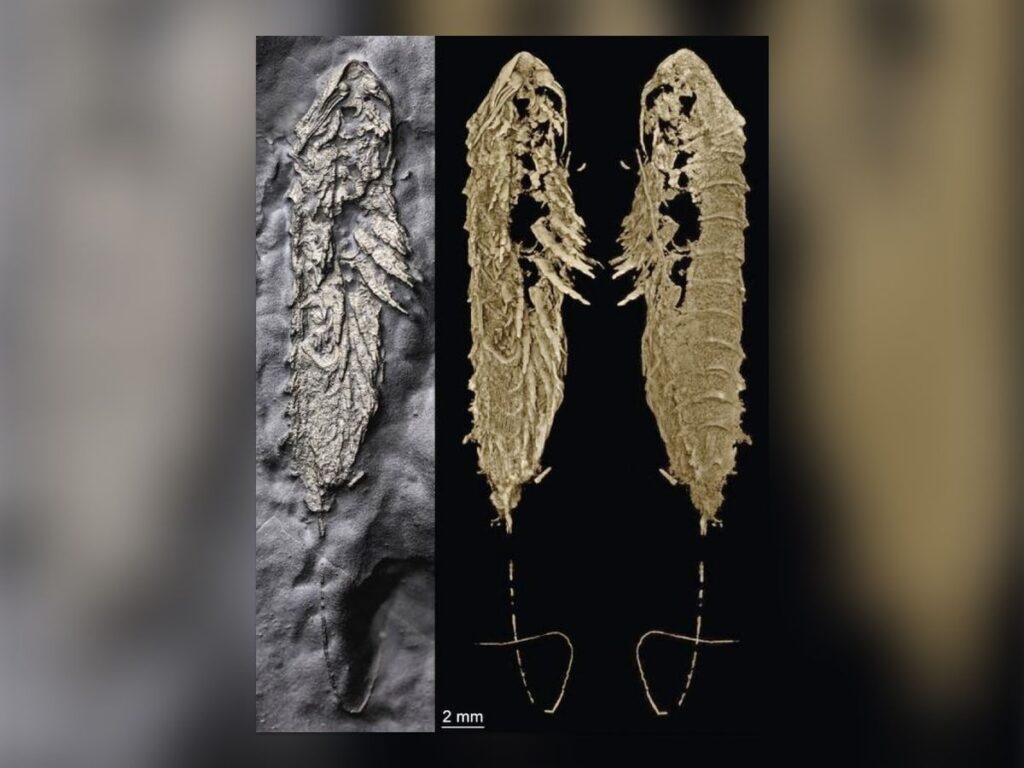The arthropod fossil used to describe a new species (left) and CT scans of the specimen (right)
Luke Parry (photograph), Yu Liu, Ruixin Ran (3D models). Edited by Emily Lankiewicz
Long ago, an unlucky arthropod was buried alive in a submarine landslide. Its memory, however, would be immortalized in the most glorious of ways: 450 million years later, scientists have uncovered its fossil, and they were shocked to see that it glitters like gold.
In a study published Tuesday in the journal Current Biology, experts reveal that the surprisingly well-preserved specimen was fossilized in 3D by iron pyrite, also known as fool’s gold, and belongs to a previously unknown extinct arthropod species.
“I was pretty blown away by how well-preserved [its appendages] were, and having worked on pyritized burrows before, I knew that they would CT scan really well,” lead author Luke A. Parry, a paleobiologist at the University of Oxford in England, tells CNN’s Katie Hunt. “Preservation in pyrite of this kind is extremely rare. In the last half a billion years, there are only a handful of examples of places where this occurs.”
The new species is called Lomankus edgecombei in recognition of arthropod expert Greg Edgecombe of London’s Natural History Museum, and it was found in a rock layer in New York state known as Beecher’s Trilobite Bed. There, researchers have uncovered an abundance of beautifully preserved trilobites, which are extinct marine arthropods.
Life reconstruction of Lomankus edgecombei
Xiaodong Wang
Arthropods are invertebrate animals that today include insects, spiders, crustaceans, centipedes and millipedes—and Lomankus edgecombei belonged to an extinct subgroup of these creatures called megacheirans. Megacheirans are known for the large, modified leg-like appendage at the front of their bodies which they used to catch prey, per a statement from the University of Oxford.
Fossils of arthropods are rare, because soft tissue often decays before it can be preserved. But with this specimen, however, scientists “get an almost complete look at their anatomy,” Parry tells Discover magazine’s Paul Smaglik. “Fossils like this tell us a great deal about what life on Earth looked like hundreds of millions of years ago, which is pretty astonishing, especially when you consider that these animals would have rotted to nothing in a matter of days under normal conditions.”
The brilliant Lomankus fossil is doubly exceptional, researchers say, because of its pyritization. In this process, the organic material of an organism’s body is replaced by pyrite over time.
“Although pyrite forms very commonly today in fine-grained marine rocks, pyritization of soft parts of organisms is very rare indeed, because you need a special set of conditions for it to replace parts of a carcass,” Parry tells Newsweek’s Aristos Georgiou.
“Pyrite forms today through the action of sulfate-reducing bacteria that break down organic material in the absence of oxygen and produce hydrogen sulfide. This can then react with iron to form pyrite, which is iron sulfide,” he explains to Newsweek. “So, to form pyrite, you need organic material, iron and a lack of oxygen.” The arthropod’s rapid burial by a landslide was also key to its preservation, because it held back decay.
Using CT scans, the scientists noted that the preserved claws of Lomankus on its front appendage were smaller than those of its ancestors and featured three “long and flexible whip-like flagella,” per the statement. The arthropod also doesn’t seem to have eyes, which suggests that its front appendage was used to sense the environment and search for food in deep, dark habitats.
“There are more species of arthropod alive than any other group of animals, and this fossil tells us what these animals looked like almost half a billion years ago in amazing detail,” Parry tells USA TODAY’s Claire Thornton.
The head of Lomankus edgecombei. From left to right: photograph of a specimen preserved so that the head is viewed from the top; 3D model of the same specimen rotated so that the underside is visible; photograph of the head of the holotype specimen; digital 3D model of the head of the holotype specimen.
Luke Parry (photograph), Yu Liu, Ruixin Ran (3D models)
The glittering fossil can also shed light on a question that scientists have long debated: How did arthropods develop the specialized mouthparts and appendages on their heads that are so common in their descendants today? For instance, think about insects’ antennae, scorpions’ pincers and spiders’ fangs.
Scientists noted that Lomankus had a “plate on the underside of the head, associated with the mouth and flanked by the great appendages,” which is similar to modern arthropods, study co-author Yu Liu, head of Yunnan Key Laboratory for Paleobiology at Yunnan University in China, explains in the statement. This suggests the iconic appendage of megacheirans could potentially be an equivalent of the ones seen today.
“Part of the key to [arthropods’] success is their highly adaptable head and its appendages, that has adapted to various challenges like a biological Swiss army knife,” Parry says in the statement.
The fossil is also evidence of the fact that although megacheirans lived during the Cambrian Period (485 million to 538 million years ago) and were mostly extinct by the Ordovician Period (443 million to 485 million years ago), some diversified and continued to thrive.
The Lomankus fossil is “one of the most visually stunning fossils I’ve ever seen. It sparkles like gold and looks like it belongs in an art museum,” Steve Brusatte, a paleontologist at the University of Edinburgh who was not involved in the study, tells CNN.
“It’s remarkable, like the whole body of this little arthropod has turned into a golden piece of jewelry,” he adds. “And that makes the fossil not only beautiful, but scientifically important.”


